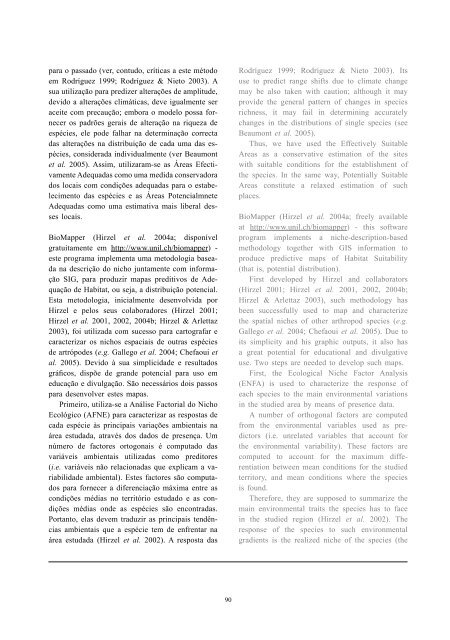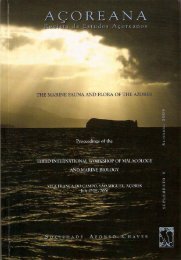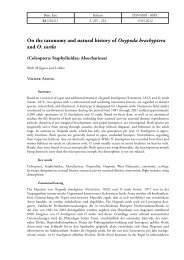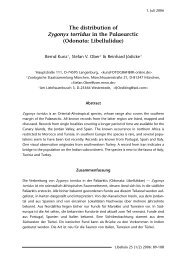(eds.) (2005). - Portal da Biodiversidade dos Açores - Universidade ...
(eds.) (2005). - Portal da Biodiversidade dos Açores - Universidade ...
(eds.) (2005). - Portal da Biodiversidade dos Açores - Universidade ...
Create successful ePaper yourself
Turn your PDF publications into a flip-book with our unique Google optimized e-Paper software.
para o passado (ver, contudo, críticas a este método<br />
em Rodríguez 1999; Rodríguez & Nieto 2003). A<br />
sua utilização para predizer alterações de amplitude,<br />
devido a alterações climáticas, deve igualmente ser<br />
aceite com precaução; embora o modelo possa fornecer<br />
os padrões gerais de alteração na riqueza de<br />
espécies, ele pode falhar na determinação correcta<br />
<strong>da</strong>s alterações na distribuição de ca<strong>da</strong> uma <strong>da</strong>s espécies,<br />
considera<strong>da</strong> individualmente (ver Beaumont<br />
et al. <strong>2005</strong>). Assim, utilizaram-se as Áreas Efectivamente<br />
Adequa<strong>da</strong>s como uma medi<strong>da</strong> conservadora<br />
<strong>dos</strong> locais com condições adequa<strong>da</strong>s para o estabelecimento<br />
<strong>da</strong>s espécies e as Áreas Potencialmnete<br />
Adequa<strong>da</strong>s como uma estimativa mais liberal desses<br />
locais.<br />
BioMapper (Hirzel et al. 2004a; disponível<br />
gratuitamente em http://www.unil.ch/biomapper) -<br />
este programa implementa uma metodologia basea<strong>da</strong><br />
na descrição do nicho juntamente com informação<br />
SIG, para produzir mapas preditivos de Adequação<br />
de Habitat, ou seja, a distribuição potencial.<br />
Esta metodologia, inicialmente desenvolvi<strong>da</strong> por<br />
Hirzel e pelos seus colaboradores (Hirzel 2001;<br />
Hirzel et al. 2001, 2002, 2004b; Hirzel & Arlettaz<br />
2003), foi utiliza<strong>da</strong> com sucesso para cartografar e<br />
caracterizar os nichos espaciais de outras espécies<br />
de artrópodes (e.g. Gallego et al. 2004; Chefaoui et<br />
al. <strong>2005</strong>). Devido à sua simplici<strong>da</strong>de e resulta<strong>dos</strong><br />
gráficos, dispõe de grande potencial para uso em<br />
educação e divulgação. São necessários dois passos<br />
para desenvolver estes mapas.<br />
Primeiro, utiliza-se a Análise Factorial do Nicho<br />
Ecológico (AFNE) para caracterizar as respostas de<br />
ca<strong>da</strong> espécie às principais variações ambientais na<br />
área estu<strong>da</strong><strong>da</strong>, através <strong>dos</strong> <strong>da</strong><strong>dos</strong> de presença. Um<br />
número de factores ortogonais é computado <strong>da</strong>s<br />
variáveis ambientais utiliza<strong>da</strong>s como preditores<br />
(i.e. variáveis não relaciona<strong>da</strong>s que explicam a variabili<strong>da</strong>de<br />
ambiental). Estes factores são computa<strong>dos</strong><br />
para fornecer a diferenciação máxima entre as<br />
condições médias no território estu<strong>da</strong>do e as condições<br />
médias onde as espécies são encontra<strong>da</strong>s.<br />
Portanto, elas devem traduzir as principais tendências<br />
ambientais que a espécie tem de enfrentar na<br />
área estu<strong>da</strong><strong>da</strong> (Hirzel et al. 2002). A resposta <strong>da</strong>s<br />
90<br />
Rodríguez 1999; Rodríguez & Nieto 2003). Its<br />
use to predict range shifts due to climate change<br />
may be also taken with caution; although it may<br />
provide the general pattern of changes in species<br />
richness, it may fail in determining accurately<br />
changes in the distributions of single species (see<br />
Beaumont et al. <strong>2005</strong>).<br />
Thus, we have used the Effectively Suitable<br />
Areas as a conservative estimation of the sites<br />
with suitable conditions for the establishment of<br />
the species. In the same way, Potentially Suitable<br />
Areas constitute a relaxed estimation of such<br />
places.<br />
BioMapper (Hirzel et al. 2004a; freely available<br />
at http://www.unil.ch/biomapper) - this software<br />
program implements a niche-description-based<br />
methodology together with GIS information to<br />
produce predictive maps of Habitat Suitability<br />
(that is, potential distribution).<br />
First developed by Hirzel and collaborators<br />
(Hirzel 2001; Hirzel et al. 2001, 2002, 2004b;<br />
Hirzel & Arlettaz 2003), such methodology has<br />
been successfully used to map and characterize<br />
the spatial niches of other arthropod species (e.g.<br />
Gallego et al. 2004; Chefaoui et al. <strong>2005</strong>). Due to<br />
its simplicity and his graphic outputs, it also has<br />
a great potential for educational and divulgative<br />
use. Two steps are needed to develop such maps.<br />
First, the Ecological Niche Factor Analysis<br />
(ENFA) is used to characterize the response of<br />
each species to the main environmental variations<br />
in the studied area by means of presence <strong>da</strong>ta.<br />
A number of orthogonal factors are computed<br />
from the environmental variables used as predictors<br />
(i.e. unrelated variables that account for<br />
the environmental variability). These factors are<br />
computed to account for the maximum differentiation<br />
between mean conditions for the studied<br />
territory, and mean conditions where the species<br />
is found.<br />
Therefore, they are supposed to summarize the<br />
main environmental traits the species has to face<br />
in the studied region (Hirzel et al. 2002). The<br />
response of the species to such environmental<br />
gradients is the realized niche of the species (the

















